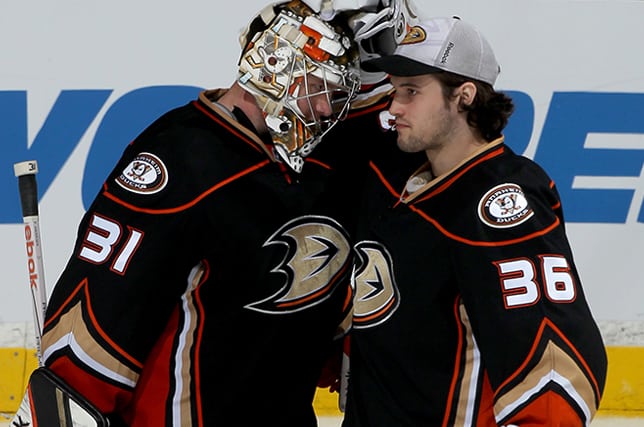

Frederik Andersen has an excellent poker face. Or he's one affable, accommodating young man. Or both.
Because, if you try to grill him about his role in the Anaheim Ducks' net and, more specifically, his platoon with John Gibson, Andersen won't concede any frustration or trepidation. He says he likes how a timeshare with Gibson keeps both goalies regularly "hungry and rested." Andersen believes having any lineup deep enough that it's forced to sit out good players, not just in net but at every position, is clearly a contender. He doesn't betray any notion that a 1A/1B goaltending split is a pain in the neck.
"It's nothing I want to worry too much about," Andersen said. It's just, 'Go out and play, and make sure to do my job, and good things will happen.' I'll stay focused on me.
"Everyone wants to play every night, but we're both comfortable going back and forth."
And, hey, the numbers suggest Andersen has a point. He's 21-9-4 with a 2.29 goals-against average and .920 save percentage over 41 appearances. Gibson is 17-11-2 with a 2.13 GAA, a .917 SP and an All-Star Game appearance. Both men have flourished. Meanwhile, in St. Louis, Brian Elliott and Jake Allen have combined for four consecutive shutouts. The Ducks and Blues sit comfortably in playoff positions. So do the Dallas Stars, who deploy Antti Niemi and Kari Lehtonen in a netminding tandem. We've seen plenty of teams over the years ride the hot hand in goal and excel in the regular season. Andersen seems to like feeling fresh and, in Dallas, signing Niemi to platoon with Lehtonen was a deliberate attempt by GM Jim Nill to manage the tough travel schedule with well-rested puck-stoppers.
But what happens to 1A/1B tandem teams in the post-season? Even if they settle at the last minute on a "starter," does it pay to have him looking over his shoulder in Game 1, knowing one bad period could leave him benched for the start of Game 2? Jonathan Quick never has to worry about that in Los Angeles, nor does Henrik Lundqvist in New York. And the numbers suggest teams committed to one goalie for the full playoffs have a much stronger shot at winning the Cup.
For starters, six of the past seven Stanley Cup champion teams have had a single goalie record all 16 of the wins required to hoist the chalice, the exception being Chicago's Corey Crawford last spring. He won 13 games and Scott Darling won three. I explained that stat to Andersen, but he shrugged it off quickly.
"Simple math if we win eight and eight," he said, envisioning a Stanley Cup duo of him and Gibson.
It's a fun idea, adorable even, but history tells us a "hot hand" approach rarely if ever results in a Cup. Of the past 30 champions, 29 have had one goalie gain at least 13 of the wins en route to the Cup. The only team over that stretch that didn't was the 1991 Pittsburgh Penguins, and that was only because Tom Barrasso missed some games due to injury. He was the full-time starter in spirit.
On the 1984 Cup-winning Edmonton Oilers, Grant Fuhr won 11 games and Andy Moog won four (as it only took 15 wins for a championship back then). To find a true platoon among champs, though, you have to go all the way back to the 1972 Boston Bruins, who had Eddie Johnston and Gerry Cheevers each get half the wins required. That's one occurrence in 42 seasons.
So when the playoffs roll around, Ducks coach Bruce Boudreau, Blues coach Ken Hitchcock and Stars coach Lindy Ruff would be wise to commit to one stopper. Will they?
“I’ve been asked that question a lot," Boudreau said Thursday night after his team's 6-5 overtime loss to the Toronto Maple Leafs. "I don’t know what we’re doing yet. We’ll have a discussion when we get back home and go from there.”
The numbers, while circumstantial, suggest flip-flopping virtually excludes a team from winning it all. In many years, the Cup champ rolls with one goalie simply because that goalie is amazing. It didn't take a genius to play Patrick Roy or Martin Brodeur or Ken Dryden every game. And declaring a starter on a team with suspect goaltending is easier said than done, of course, as it's natural to want to yank a shaky stopper if he struggles out of the gate in the post-season. In many instances, though, a coach has been rewarded for committing to one less-established starter who wasn't anointed as such during the regular season. Crawford split time with Ray Emery in 2013, but Crawford was The Man for Chicago in the post-season. Carolina Hurricanes Conn Smythe Trophy winner Cam Ward wrested the job away from Martin Gerber in 2006, and coach Peter Laviolette rode Ward to 15 of the Hurricanes' wins.
So if you want to hoist the Cup…choose one goaltender and give him a long leash. Or, if you're that goaltender, play so well that it's impossible to pull you.
Matt Larkin is an associate editor at The Hockey News and a regular contributor to the thn.com Post-To-Post blog. For more great profiles, news and views from the world of hockey, subscribe to The Hockey News magazine. Follow Matt Larkin on Twitter at @THNMattLarkin
